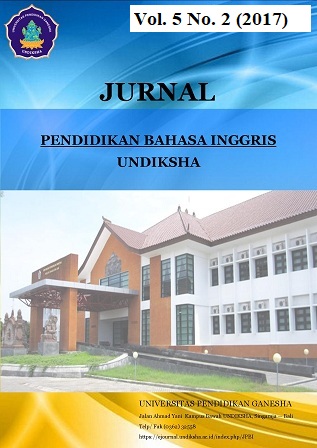AN ANALYSIS OF JARGON USED BY RECEPTIONISTs IN FRONT OFFICE AT LOVINA BEACH HOTEL
DOI:
https://doi.org/10.23887/jpbi.v5i2.12235Abstract
Penelitian ini bertujuan untuk mengindentifikasi dan analisis bentuk-bentuk linguistics, arti dan fungsi jargon yang digunakan oleh petugas front officers di bagian front office Lovina Beach Hotel. Dalam menganalisis jargon didukung oleh theory Allan&Burridge(2006), theory yule (2006), dan theory chaer and Agustina’s (2010). Penelitian ini menggunakan kualitatif. Penelitian pada jargon diteliti berdasasrkan bentuk pembicaraan dan bentuk tulisan. Penelitin ini dilaksanakan di Lovina Beach Hotel yang beralamat Desa Kalibubuk-Kecamatan Buleleng-Kabupaten Buleleng. Subject penelitian dalam penelitian ini adalah Front officers di Front Office, hotel Lovina Beach Hotel. Object penilitian ini adalah jargon yang digunakan dalam proses komunikasi dan interaksi antara orang-orang dengan kelompok, orang-orang dengan orang lain, kelompok dengan kelompok di Front Office. Dalam penilitian ini ditemukan berbagai bentuk jargon seperti phrasa (2 or 1,9 %), Singkatan (30 or 28%), Kata-kata (45 or 42 %), Pemendekan ( 19 or 10,9%), Peminjaman (2 or 1,9 %), Pengabungan (2 or 1,9%) and Akronym (5 or 4,7%). Dalam istilah arti jargon bahwa terdapat sebanyak 105 arti jargon. Berdasarkan teori Allan dan Burridge (2006, p.58) jargon memiliki dua fungsi pertama (1) jargon untuk menyajikan sebagai teknis atau spesialis bahasa untuk berkomunikasi yang tepat dan effisiensi dalam berkomunikasi (51, 54 %). Kedua (2) jargon sebagai bentuk memajukan bahasa dalam kelompok solidaritas dan diluar dari kelompok solidaritas kepada orang-orang yang tidak menggunakan jargon (51, 48%).Kata Kunci : jargon, front office department, lovina beach hotel.
This study aimed at identify and analyze the the linguistics forms, the meanings and the function of jargon used by front officers of the front office department at Lovina Beach Hotel. The analysing of jargon was supported by Allan&Burridge (2006) theory,Yule’s (2006) theory and Chaer & Agustina’s (2010) theory. This study was conducted in a qualitative research design. The jargons was investigated based on spoken and written form. This study was conducted at Lovina Beach Hotel and located in Kalibubuk Village Buleleng Subdistrict- Buleleng Regency.The subjects of the study were receptionists at the front office department of Lovina Beach Hotel.The object of this research was jargon used in the process of communicating and interacting people with groups, people with people and group with group in front office department. This study found the types of jargon in form of phrases (2 or 1,9 %), abbreviation (30 or 28%), words (45 or 42 %), clipping ( 19 or 10,9%), borrowing (2 or 1,9 %), compounding (2 or 1,9%) and acronym (5 or 4,7%). Terms of the meaning, there were 105 jargons meaning. According to Allan and Burridge (2006, p.58) jargon has two functions, as follows.Firstly, to serve as a technical or specialist language for precise and economical communication (51, 54 %).Secondly,to promote in-group solidarity, and to exclude as out-groupers, the people who do not use the jargon (51, 48%)
keyword : Keyword : jargon, front office department, lovina beach hotel.
Published
2017-10-26
Issue
Section
Articles
License
Authors who publish with the Jurnal Pendidikan Bahasa Inggris Undiksha agree to the following terms:- Authors retain copyright and grant the journal the right of first publication with the work simultaneously licensed under a Creative Commons Attribution License (CC BY-SA 4.0) that allows others to share the work with an acknowledgment of the work's authorship and initial publication in this journal
- Authors are able to enter into separate, additional contractual arrangements for the non-exclusive distribution of the journal's published version of the work (e.g., post it to an institutional repository or publish it in a book), with an acknowledgment of its initial publication in this journal.
- Authors are permitted and encouraged to post their work online (e.g., in institutional repositories or on their website) prior to and during the submission process, as it can lead to productive exchanges, as well as earlier and greater citation of published work. (See The Effect of Open Access)













